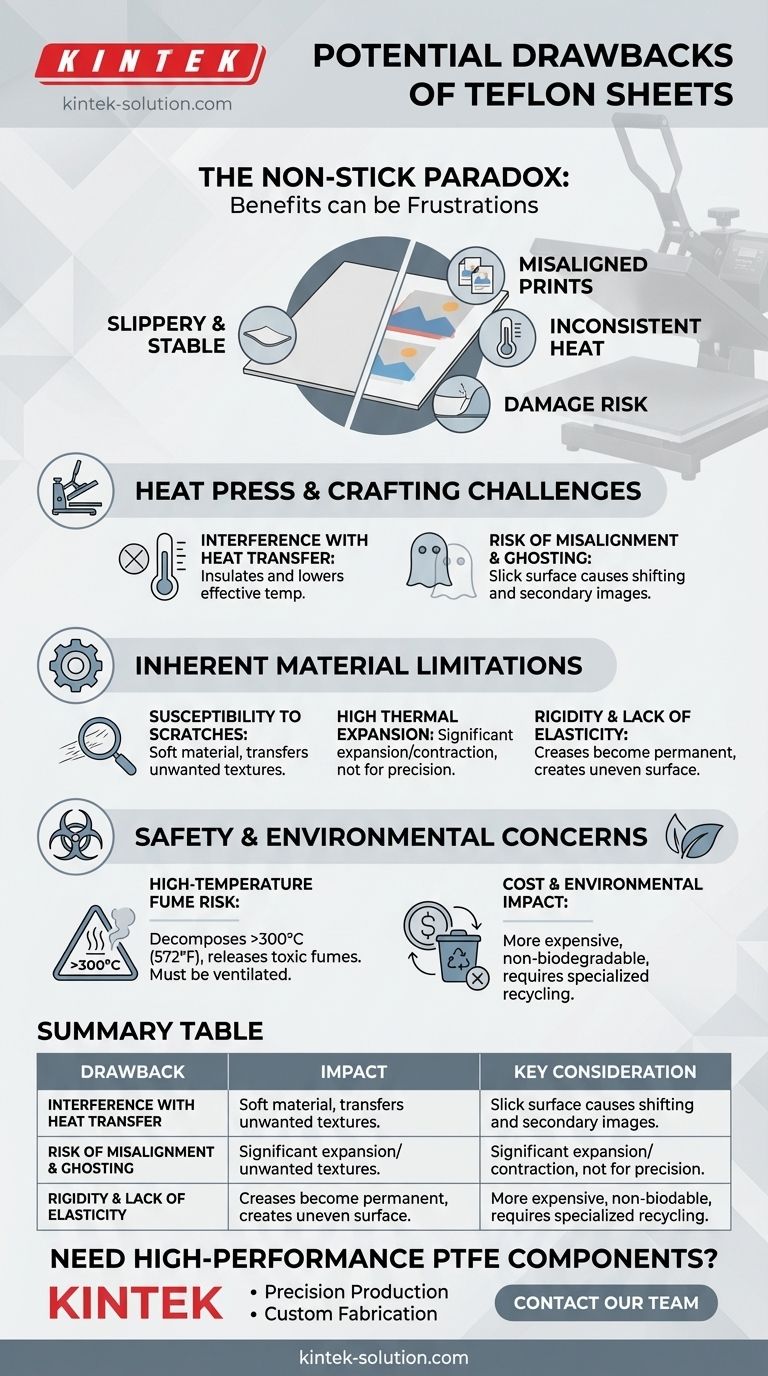While prized for their non-stick surface, Teflon sheets have several key drawbacks. These include interfering with precise heat transfer, causing designs to slip during application, and a susceptibility to scratches that can affect your final product. At very high temperatures, they can also release harmful fumes, posing a significant safety risk.
The core challenge with Teflon sheets stems from a paradox: their most celebrated features—being slippery and thermally stable—are also the source of their biggest frustrations. This can lead to misaligned prints, inconsistent heat, and requires careful handling to avoid damage and safety risks.

Drawbacks in Heat Press & Crafting Applications
This is the context where most users encounter Teflon's limitations. The very properties that make it useful as a protective barrier can also compromise the quality of your work.
Interference with Heat Transfer
A Teflon sheet acts as an insulator, absorbing a certain amount of heat from your press. This can slightly lower the effective temperature reaching your design, potentially impacting the vibrancy and adhesion of the transfer.
Risk of Misalignment and "Ghosting"
The extremely slick surface that prevents sticking can also allow your transfer paper or vinyl to shift when you close the press. This movement often results in crooked or misaligned prints. In dye-sublimation, this slippage can cause a faint, secondary image known as "ghosting."
Inherent Material & Chemical Limitations
Beyond specific applications, the base material (PTFE) has intrinsic properties that create disadvantages in various scenarios.
Susceptibility to Scratches
Despite its durability in terms of reuse, Teflon is a relatively soft material. The surface is prone to scratches and abrasions, which can transfer unwanted textures to your projects over time.
High Thermal Expansion
Teflon expands and contracts more significantly with temperature changes than most other plastics. This property is less of a concern for a simple flat sheet but is a critical limitation in precision engineering applications where tight tolerances are required.
Rigidity and Lack of Elasticity
Unlike silicone or rubber, solid Teflon is quite rigid and has no elastic memory. If you put a sharp crease in a Teflon sheet, that crease will likely remain permanently, creating an uneven surface for future pressings.
Understanding the Trade-offs and Safety Concerns
To use any tool effectively, you must understand its compromises and potential hazards. Teflon is no exception.
The Non-Stick Paradox
Teflon's primary benefit is its non-stick nature, which makes it excellent for protecting your equipment. However, this same property makes it impossible to bond with adhesives and is the direct cause of the alignment issues mentioned earlier.
High-Temperature Fume Risk
This is the most significant safety consideration. When heated above 300°C (572°F), Teflon can begin to decompose and release toxic polymer fumes that are hazardous to inhale. Always work in a well-ventilated area and operate your equipment within the recommended temperature ranges.
Cost and Environmental Impact
Teflon sheets are generally more expensive than single-use alternatives like parchment paper. The material is also not biodegradable, though it can be recycled in specialized industrial facilities.
How to Apply This to Your Project
Understanding these drawbacks allows you to use Teflon sheets more effectively or choose a better alternative for your specific task.
- If your primary focus is perfect alignment in heat pressing: Be aware of the "slip factor" and always use high-temperature tape to secure your transfer before pressing.
- If your primary focus is temperature-sensitive applications like sublimation: Account for potential heat absorption by performing a test press to dial in your settings, possibly increasing temperature or duration slightly.
- If your primary focus is durability and long-term use: Handle your sheet with care, store it flat or loosely rolled, and inspect it for scratches or debris before each use to protect your work.
By acknowledging its limitations, you can mitigate the risks and leverage Teflon's unique properties to your advantage.
Summary Table:
| Drawback | Impact | Key Consideration |
|---|---|---|
| Interferes with Heat Transfer | Can lower effective press temperature | May require adjusted time/temp settings |
| Causes Slippage & Misalignment | Leads to crooked prints or ghosting | Use high-temp tape to secure designs |
| Susceptible to Scratches | Can transfer imperfections to projects | Handle with care and inspect regularly |
| Releases Toxic Fumes >300°C | Significant health hazard | Always use in a well-ventilated area |
| High Thermal Expansion | Not ideal for precision engineering | Consider alternative materials for tight tolerances |
Need High-Performance PTFE Components Without the Drawbacks?
At KINTEK, we understand the critical balance between non-stick performance and practical application challenges. Our expertise in precision PTFE manufacturing allows us to create components—from seals and liners to custom labware—that are engineered for reliability and safety in the most demanding environments.
We serve semiconductor, medical, laboratory, and industrial clients by prioritizing:
- Precision Production: Ensuring consistent quality and performance.
- Custom Fabrication: Tailoring solutions from prototypes to high-volume orders to meet your exact needs, potentially mitigating common issues like slippage or heat interference.
Let's engineer a better solution for your application. Contact our team today to discuss your requirements.
Visual Guide

Related Products
- Custom PTFE Parts Manufacturer for Teflon Containers and Components
- Custom PTFE Parts Manufacturer for Teflon Parts and PTFE Tweezers
- Custom PTFE Sleeves and Hollow Rods for Advanced Applications
- Custom PTFE Measuring Cylinders for Advanced Scientific and Industrial Applications
- Customizable PTFE Rods for Advanced Industrial Applications
People Also Ask
- Why is dimensional stability a concern when machining PTFE? Ensure Accurate, Stable PTFE Components
- What is the temperature range that PTFE can withstand? From -200°C to +260°C for Demanding Applications
- How does PTFE compare to other low-friction plastics like UHMW-PE and Nylon? A Guide to Material Selection
- What is the working temperature range of PTFE? Master Extreme Heat and Cryogenic Applications
- When and by whom was PTFE discovered? A Tale of Accidental Innovation



















